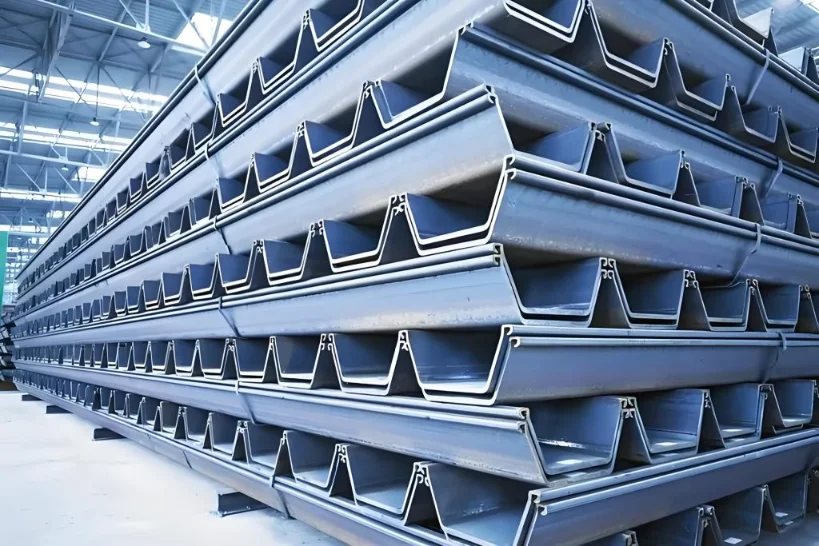
You care about getting the grade right the first time. If you want a quick route to specs, sections, and real-world availability. With that set, let’s dive into where S235 steel piles make sense, where they do not, and how to decide without over-engineering.This guide leads who want a clean way to decide if S235 fits the load case and site constraints. The topic is practical: axial and lateral capacity, drivability, corrosion, QA paperwork, and total installed cost. You will not see hype here, just the checks most teams already run—laid out in one place so decisions move faster. Start at the project gateway on the Sunrise New Material site.
What You Will Take Away First
A simple rule: use S235 when capacity and stiffness checks clear with margin, site installation is straightforward, and corrosion risk is addressed by coating or allowance. Step up in grade when spans, moments, or fatigue push limits that S235 cannot comfortably meet at the target section.
What Project Inputs Do You Need Before Picking a Pile?
Before you debate grade, lock the inputs. Skipping this step leads to rework. A few hours up front can save a week on site.
A cohesive shortlist helps: soil profile, expected loads, and environmental exposure. Then add site access, noise limits, and what equipment can actually get to the line. Finally, look at lead time and splicing strategy. With those in hand, the grade question becomes a calculation, not a guess.
Soil Data and Testing: CPT, SPT, and Lab Parameters
Cone and standard penetration data define unit skin friction and end bearing. Clay sensitivity, sand density, organics—these drive the choice between end bearing and friction reliance. If the numbers show low friction or thick weak layers, consider section shape and tip details that densify or cut to bearing.
Load Cases: Axial, Lateral, Uplift, and Fatigue
Compression governs many foundations, but lateral and uplift decide pile type in ports, seismic zones, and tall frames. If the job sees repeated load cycles, keep an eye on weld details at splices and connections, not just nominal grade.
Site Constraints: Noise, Vibration, Headroom, and Utilities
Urban projects live inside pile driving noise and vibration limits. Access, overhead restrictions, and buried services can all favor certain installation methods or even press-in systems. Grade selection follows these constraints because wall thickness, shape, and splicing method affect driving resistance and site time.
Environment: Marine, Splash Zone, Groundwater, and Aggressive Soils
Salt water, tidal ranges, and stray currents accelerate corrosion. In those zones, the durability plan—coatings, cathodic protection, or corrosion allowance—sits beside grade choice. You deal with both, not one.
Commercials: Lead Time, Transport Lengths, and QA Docs
Stock lengths reduce waiting. Splicing plans reduce crane time. Mill test certificates and NDT make handover smoother. All of this affects total installed cost more than a small difference in grade price per ton.
When Does an S235 H-Pile Make the Most Sense?
If you want high axial capacity in a slim footprint over varied soils, H-piles in S235 deliver a lot for the weight. The flange-web geometry bites into dense layers and guides alignment during driving. Splices are straightforward, and many crews know the workflow by heart.
Before listing the common cases, keep the core idea: if axial governs and lateral demands are moderate, S235 H-piles clear checks with room to spare while keeping welding and handling simple.
High Axial Capacity With Dense or Variable Soils
Where CPT shows interbedded layers, H-piles often seat to a firm stratum with reliable end bearing. S235’s yield is adequate when safety factors and service loads are respected.
Flange-Web Geometry for Alignment and Splicing
The shape aids visual line-up and makes mechanical splices or butt welds more predictable in the field. That cuts fit-up time and reduces re-drives.
Typical Uses: Building Cores, Abutments, Fender Lines
Gravity-driven structures with defined load paths—cores, approach slabs, fenders—see repeatable axial work. S235 is a steady, known quantity here.
Limits to Watch: Lateral Stiffness and Weak Layers
If lateral moments dominate or if weak layers are thick and continuous, check deflection carefully. An H-pile may need a thicker section or a higher grade for stiffness rather than strength alone.
When Should You Choose an S235 Pipe Pile?
Pipe piles bring superior lateral stiffness and moment capacity, which matters in seismic frames, wharfs, and sheets-plus-pipes composite systems. The round section resists buckling in soft layers better than you might expect, provided wall thickness is selected with local buckling checks.
Bridge to the details with one thought: choose pipe when lateral or combined actions rule the design, and when your equipment can handle the higher driving resistance.
Lateral Stiffness and Seismic or Port Work
The second moment of area on a pipe, even at moderate diameter, helps control deflection. This is critical where serviceability limits are tight.
Open vs Closed Ends, Shoes and Tips
Open ends can plug for friction; closed ends and shoes help reach end bearing or punch through obstructions. Match the tip to the soil model.
Grouting, Concrete Filling, and Composite Action
Concrete-filled pipes can boost stiffness and improve fatigue behavior. Plan for venting and cure time in the schedule.
Trade-Offs: Wall Thickness, Welding, and Drive Time
More thickness and larger diameter raise weight and driving effort. Factor this into rig selection and daily outputs.
When Is an S235 Sheet Pile the Right Call?
Sheet piles excel when the foundation doubles as a wall: basements, cofferdams, channel lining, and erosion control. The interlock gives continuity and watertightness with the right sealant and driving quality.
The key link to grade here is durability. Axial capacity is not the selling point. It is the ability to form a continuous cut-off or retaining face with predictable deformation.
Continuous Walls, Cut-Offs, and Excavation Support
If the job needs excavation support and permanent seepage control, sheet piles solve both with one system.
Interlock Types, Water Tightness, and Detailing
Different interlocks change leak paths and installation tolerance. Sealants and welding at corners matter more than grade.
Cantilever vs Anchored or Strutted Systems
Cantilevered walls suit shallow cuts; deeper works need anchors or struts. Grade checks remain simple if displacement limits are met.
Limits: Axial and Point Loads Versus H- or Pipe Piles
Do not load a sheet like a column. If concentrated loads appear, switch type or add bearing members.
Which Installation Method Fits Your Site?
Installation determines schedule risk and neighborhood impact. Grade is only half the story; method is the other half.
A simple filter helps. If the site allows impact hammers and noise windows are generous, impact gives reliable set criteria. If vibration limits are tight, a press-in system or pre-drill may be the only choice. This is where pile driving noise and vibration limits shape both the section pick and the calendar.
Impact Driving: Bearing and Set Criteria
A clear blow count at refusal provides confidence in capacity. Record keeping is easy, inspectors know the steps.
Vibratory Driving: Speed vs Settlement
Fast in sands and gravels, but watch induced settlement near sensitive structures. Plan monitoring and trigger levels.
Silent Press-In: Urban or Restricted Sites
When neighbors or hospitals sit next door, press-in solves noise and vibration issues at the cost of speed. Pre-drilling helps where obstructions stack up.
Bored/Driven Hybrids and Pre-Drilling
Through hard layers or cobbles, pre-drill to the target depth, then drive or press the pile. It protects interlocks and saves time.

What About Corrosion Protection and Service Life?
Durability makes or breaks marine and waterfront projects. You protect S235 with coatings, cathodic systems, or simple corrosion allowance. The choice is a balance of inspection access, replacement tolerance, and life-cycle cost.
Keep one practical note: marine corrosion protection for steel piles begins in design, not after delivery. Specify the coating system, thickness, and repair protocol early so procurement lines up the right work.
Coating Systems: HDG, Epoxy, and Polyurethane
Hot-dip galvanizing, epoxy build coats, and polyurethane topcoats each suit different zones. The splash zone is the most punishing; add thickness and detail edges well.
Cathodic Protection Basics
Sacrificial anodes or impressed current reduce corrosion rates in immersion. Coordinate with coating to avoid stray current issues.
Corrosion Allowance vs Coating
Sometimes adding a few millimeters of wall thickness is cheaper than complex coating and inspection on buried sections. Consider both.
How Do You Splice, Weld, and Document Quality?
Quality control turns into handover speed when records are tidy. Welding procedures, welder qualifications, and inspection logs keep stakeholders aligned and reduce disputes.
The key is consistency. If a splice design repeats, set a standard WPS and inspection plan so each shift knows the drill.
WPS/PQR, Qualifications, and Fit-Up Tolerances
Document procedures, qualify people, and measure gaps. These reduce rework more than any single material choice.
Field vs Shop Splicing, Sleeve vs Butt
Shop welds are cleaner; field welds save transport headaches. Sleeve splices add weight; butt splices add setup time. Choose based on crane hours and road limits.
Inspection and Records: NDT and MTC
Ultrasonic or radiographic checks where needed, visual and magnetic particle elsewhere. Keep mill certificates and traceability consistent with the section list.
How Do You Compare Cost and Schedule Across Pile Types?
Think in total installed cost: steel weight, drive time, equipment day rates, and risk premiums. A lighter section that drives slowly can cost more than a heavier one that drives clean.
A simple worksheet helps the team compare equal risk assumptions. It also highlights where delays hide—mobilization, re-drives, weather windows, or waiting on coatings.
Material vs Installed Cost
List tonnage, hammer time, crew size, and rig type. Small changes in productivity have big effects on budget.
Lead Times, Stock Lengths, and Transport
Stock lengths reduce waiting and splices. Oversized pieces can blow transport windows or route permits.
Risk Premiums: Obstructions and Weather
Allow time for obstructions and restrikes. Price them in, do not pretend they will not happen.
Who Is Qingdao Sunrise New Material Co., Ltd.
Qingdao Sunrise New Material Co., Ltd. supplies structural pile sections with steady quality control and clear paperwork. You get stock ranges for H-piles, pipe piles, and sheet piles in S235 with cut-to-length service to match crane time on site. Welding data and inspection records map cleanly to common standards, which speeds submittals and sign-offs. If you need specs and a single place to start a cut list, review s235 steel piles on the product page and send drawings through Contact for a quick grade and section check. Coating coordination—galvanizing or paint systems—is handled in one conversation so you do not juggle multiple vendors. That trio of stock readiness, documentation clarity, and delivery timing supports repeat industrial work where a missed day can ripple across the whole schedule.
FAQ
Q1: When Is S235 the Right Grade for Foundation Piles?
A: When axial and lateral checks clear with margin, site driving is straightforward, and durability is handled by coating or allowance. In those cases, S235 gives reliable capacity at a sensible cost.
Q2: Which Pile Type Works Best for Lateral Loads?
A: Pipe piles usually offer higher lateral stiffness and moment capacity. H-piles can work with bracing, but for seismic or quay walls, pipes often control deflection better.
Q3: How Do You Deal With Pile Driving Noise and Vibration Limits?
A: Use vibratory or press-in systems for sensitive sites, set monitoring triggers, and plan sequencing. Pre-drilling or cushions can help meet local limits without stalling production.
Q4: What Is the Basic Plan for Marine Corrosion Protection for Steel Piles?
A: Specify a coating system suited to immersion and splash zones, consider cathodic protection underwater, and add corrosion allowance where inspection is hard. Write repair protocols into the contract.
Q5: Do You Need Higher Grades Like S275 or S355 if the Soil Is Poor?
A: Not automatically. Poor soils often point to pile type, diameter, or length changes first. Use higher grade when stiffness or fatigue governs and S235 cannot meet limits without excessive section size.






